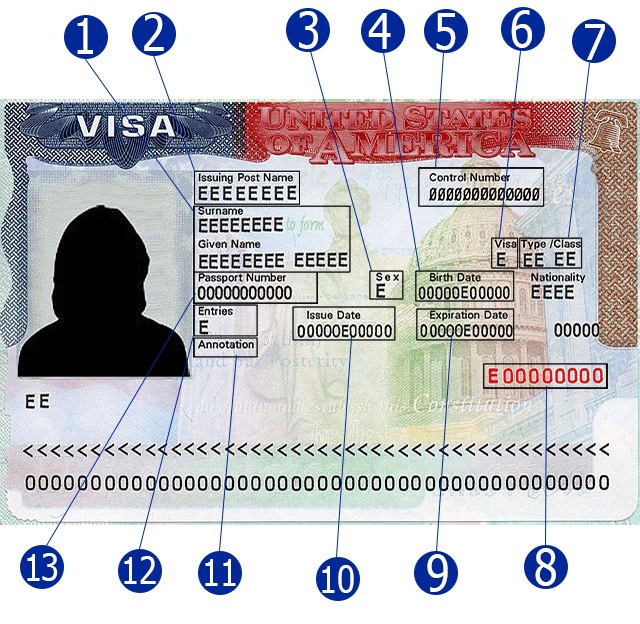If the U.S. embassy or consulate granted you a U.S. visa, the officer likely placed a visa stamp inside your passport. The U.S. visa stamp is the physical document that is placed in your passport by the consular officer.
With a valid, unexpired U.S. visa stamp, you may apply for admission to the United States of America at a port of entry. At the port of entry, a U.S. Customs and Border Protection (CBP) officer will review the visa in the passport and all supporting documents to determine if you may enter.
How to Read a U.S. Visa
The U.S. visa stamp provides the inspecting CBP officer at the port of entry with the information necessary to admit you to the U.S. under a specified visa status and for a specific period of time. Inaccuracies or incorrect information can lead to significant problems. Therefore, its vital that you inspect the visa at the time issue to ensure everything is correct. This article will help you understand the various information so that you know how to read a U.S. visa stamp. Refer to the sample visa below to follow along.

1 | NameYour given name and surname (family name) should both match exactly what is printed on the biometric page of your passport. |
2 | Issuing PostYour visa’s issuing post is generally the location of the U.S. embassy or consulate that granted the visa. |
3 | SexThe sex should match exactly the type recorded on the passport. |
4 | Birth DateThe date of birth should match exactly the date recorded on the passport. |
5 | Visa Control NumberThe control number is the upper right corner of the standard U.S. visa stamp is assigned by the Department of State to keep track of visa issuances. For the typical visa holder, this number has no significance. |
6 | VisaFor visa, “R” is an abbreviation for “regular” passport. |
7 | Type/ClassThe code under type/class indicates the visa classification and describes the purpose of your travel. For most visitors, you will see “B1/B2” in this space. |
8 | Visa NumberThe visa number, also called a visa foil number, is a red number that is generally printed on the bottom right side of newer visa documents. In most cases, the U.S. visa number contains eight numeric characters. In some cases, the number contains one letter followed by seven numeric characters. |
9 | Expiration DateThe date your visa expires is the last day that you may seek entry. It does not necessarily mean that you may stay in the United States until this date. Some U.S. visas may be valid for 10 years. However, this only means that the visa holder may use the document to enter the U.S. during the 10-year period. A Form I-94 Arrival/Departure Record includes the “Admit Until Date.” |
10 | Issue DateThis date is when the U.S. embassy or consulate issued your visa. |
11 | AnnotationThe annotation may include additional information about your visa. For example, a J-1 visa may have information about the exchange program. Or an F-1 student’s visa may have your SEVIS number and name of your school. |
12 | EntriesThis field indicates the number of entries allowed. If there is a number here, you may apply for entry to the U.S. that many times. “M” means that you can seek entry multiple times. This is no limit. |
13 | Passport NumberCheck to make sure this number matches the number in your passport. A discrepancy can be problematic. |
Mistakes on USCIS forms can cause costly delays or a denial.
With CitizenPath, you can confidently prepare your immigration application the right way—quickly and affordably. Our attorney-reviewed software simplifies complex forms and provides a personalized checklist of supporting documents for your situation. Start your journey with peace of mind — no credit card or account required to try.Try CitizenPath today and file with confidence >>
Some People Don’t Need a Visa Stamp to Visit the United States
Not everyone requires a visa stamp in their passport to come to the United States. Certain foreign citizens are allowed to enter the U.S. without a visa for a limited period of time.
Visa Waiver Program
Visitors from U.S. Visa Waiver Program (VWP) countries may visit for a period of up to 90 days. The purpose of travel must generally be pleasure/tourism or medical treatment (reasons consistent with a B-2 visitor visa). Before traveling to the U.S., VWP visitors must receive permission to enter the U.S. through the United States’ Department of Homeland Security’s Electronic System for Travel Authorization (ESTA).
RECOMMENDED: Adjustment of Status for Visa Waiver Program Entrants
Citizens of Canada and Bermuda
Again, if traveling for general pleasure purposes, citizens of Canada and Bermuda to not require a U.S. visa stamp when visiting the United States. Unless ineligible for a visa under U.S. immigration law, or have previously violated the terms of their immigration status in the U.S., Canadian and Bermudian citizens may enter the U.S. with only their passports. When traveling for more than 180 days or for reasons inconsistent with a B-2 visa, visitors from these countries may require a nonimmigrant visa.

